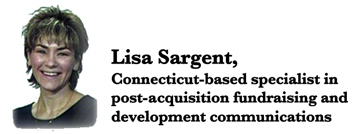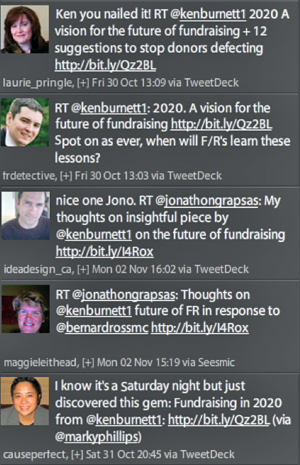|
|
‘In my opinion, the future of fundraising can’t come soon enough. Bring it on, I say. Bring it on.’ Visit Lisa Sargent’s website. ‘The dwindling results of the old burn and churn hard sales tactics began long before the current economic meltdown and will continue to accelerate downward even as the economy improves. Tomorrow is upon us.’ from Roger Craver, see below. Then visit
Back to blogs about fundraising and communication Tales from The Field by the River: |
Contrary to the feedback you may have received thus far, Ken, I don’t see your thoughts as dark, negative or any number of other doom-and-gloom adjectives one might dream up. Far from it, in fact.
The End Of An Era. Thank Heavens! A couple of days ago Tom relayed Ken Burnett’s view of what donors and fundraising will be like ten years from now. In brief, technology will put donors more in control of the channels through which we communicate with them…donors will seek greater accountability, transparency and control of how their money is spent and what value it brings…the motivations for giving won’t change much, but the focus and skill of smart and successful fundraisers will have had to change a great deal. Of course, as Ken would be the first to note, we don’t have to wait another 10 years. The dwindling results of the old burn and churn, “hard sales tactics”, as Ken calls them, began long before the current economic meltdown and will continue to accelerate downward even as the economy improves. Tomorrow is upon us. For my part, I wish every direct response fundraiser would declare an end to “The Age of Donor Acquisition” and get onboard “The Age of Conservation.” Let me explain. I spent several decades of my career during the full glory of the “Acquisition Age”—the era when new donors were plentiful and the only obstacle to success was the will to mail. While lip service was paid to retention and upgrading, the reality was that the acquisition mindset ruled the day. The metrics used in that old-fashioned era say it all: percentage of response, average gifts, RFM, ‘file size growth.’ By those metrics direct mail may not yet be dead, but that mindset put it on a respirator. Enter “The Age of Donor Conservation”. Fortunately, there are plenty of vibrant and growing fundraising programs rooted in direct mail and steered by folks who truly understand that donors are precious, not limitless. Successful strategies in “The Age of Donor Conservation” focus on life-time value, solidly based on the long-term loyalty that comes from listening to and focusing on the donors themselves. This focus, aided by sophisticated screening and modeling technologies coupled with common sense and good manners, seamlessly moves donors from small and initial gift status on to mid-level giving, then major gifts and on to the final legacy gift. Today’s reality is that the measure of a direct mail program is no longer the rate of growth in a file, but what we do with and how we communicate with the donors we have onboard today and will bring in tomorrow. Of course, as Ken points out, operating in today’s and tomorrow’s environment will require considerable skill and no small measure of hard work. In the hard work department, I was struck by the comment of Stephen Best the other day in The Agitator. He noted that the hard work of preparing handwritten letters of thanks to donors of a “modest sized” animal protection organization in Toronto had not only stemmed attrition, but had probably contributed to growth. A change of mindset and a dollop of hard work that puts the focus on your precious donors can help you realize the full potential of both your acquisition program and your existing base of donors in the months and years to come. That’s “Conservation Fundraising.” Roger
|
Ken’s reply:
Interestingly, no one yet has ventured to suggest that I’m being a bit hard on fundraisers. That, in itself, perhaps speaks volumes. Back to home.
My response to Roger’s post, opposite Well said Roger, The shift you talk about is long overdue, and a number of people have been saying so for some years now. We never should have been selling to our donors, it was always inadvisable to see fundraising as a sales paradigm. The arm we once wanted to twist up their backs would always have been better draped around our shoulder, in friendship. But I remain perplexed, because I can’t quite see how we will bring this particular era to an end. People have been talking about being relationship fundraisers for two decades now. They fill the air with their good intentions at every conference I attend. Then they return to work the following Monday, and it’s back to the same old, same old. I like the term conservation fundraising. I’d like to see the emphasis in fundraising switch from marketing to communication. But I think maybe it’s up to the brightest and best of the new generation of young, energetic fundraisers to work out how this will happen, and to make it happen. A small percentage of bright fundraisers are now leading the way and we should focus on them and their endeavors now. We older fundraisers have clearly failed, not perhaps to make the point, but to make the change actually happen (which is the difficult bit). All power to The Agitator for promoting this message. Ken
|
 Comment
Comment





